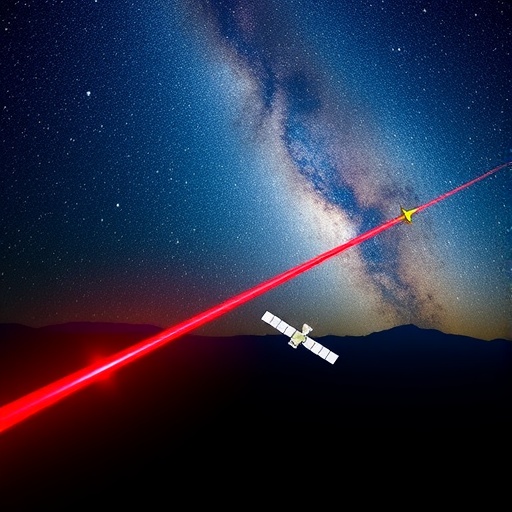The field of optical communications has been significantly advanced by a groundbreaking collaboration among the National Institute of Information and Communications Technology (NICT), the Nagoya Institute of Technology (NITech), and the Japan Aerospace Exploration Agency (JAXA). This teamwork has led to an unprecedented demonstration of next-generation error correction codes, designed to combat the effects of atmospheric turbulence on ground-to-satellite laser communications. In an age where satellite communication is becoming increasingly critical for various applications, the mitigation of data transmission errors is essential for reliability and stability.
Atmospheric turbulence is a known phenomenon that disrupts the clarity of signals transmitted through the Earth’s atmosphere. When laser signals travel from the ground to satellites, they must pass through layers of air that can vary in temperature and density. These fluctuations can cause fading, leading to burst data errors that compromise the integrity of the transmission. Thus, addressing these errors is crucial for the advancement of robust communication systems in space.
In this recent experimental endeavor, researchers successfully utilized next-generation error correction codes, specifically tailored for high correction capability. The codes in focus include the 5G New Radio Low-Density Parity-Check (5G NR LDPC) codes and Digital Video Broadcasting-Satellite Second Generation (DVB-S2) codes. These advanced coding techniques played a pivotal role in correcting burst data errors resulting from atmospheric turbulence, presenting a significant leap from traditional error correction methodologies that have been employed in satellite communications for decades.
A noteworthy aspect of this research is the practical implementation carried out by NICT, which has been tirelessly pursuing breakthroughs in ground-to-satellite laser communication technologies. The experimentation involved a 60 Mbps downlink, which allowed researchers to assess the performance of these next-generation codes in real-world conditions. By employing a one-meter optical ground station and a satellite equipped with the Laser Utilizing Communication System (LUCAS), the study provided tangible insights into how atmospheric disturbances can impact communication quality.
Data obtained during the experiment showcased the significant improvements in communication quality achieved by using 5G NR LDPC and DVB-S2 codes. Analytical assessments revealed a remarkable capacity for these codes to correct burst errors that would typically lead to communication disruptions. This result not only highlights the efficacy of innovative coding strategies but also lays the groundwork for their broader application in future satellite communication systems.
The implementation of these codes has far-reaching implications for the practical deployment of ground-to-satellite laser communications. With the increasing reliance on satellite systems for both commercial and scientific purposes, establishing a reliable means of communication is paramount. High-capacity transmission links that can withstand atmospheric interference are becoming indispensable for applications spanning from global internet services to data relay among satellites.
Technologically advanced communications, such as those under study, promise to usher in a new era of data relay systems that can leverage existing terrestrial protocols for 5G communication. The potential to integrate current standards with future satellite broadcasting systems raises intriguing possibilities for enhancing user experience and technical capabilities in spacecraft networking.
Looking to the future, this innovative work in next-generation error correction codes embodies a significant step toward the realization of effective ground-to-satellite laser communications. The subsequent improvement in communication quality and quantity is set to catalyze the integration of terrestrial network protocols into orbital communications. As we stand on the brink of a new technological frontier, these advancements have the potential to redefine how data is transferred in the increasingly interconnected sphere of space exploration.
As part of the research agenda, the study’s findings will be presented at the International Conference on Space Optical Systems and Applications (ICSOS) in 2025. This platform will further disseminate their work within the scientific community while stimulating collaboration and dialogue on essential topics related to future space communication systems.
The endeavor to enhance ground-to-satellite laser communication’s reliability extends beyond academic curiosity; it carries significant implications for improving global communication infrastructures. With mounting advances in space technologies, the development of robust communication systems could also contribute vital improvements to disaster response and management, enhancing our collective capacity to address urgent needs in critical situations.
As researchers and engineers tread further into the intricacies of optical communications, the lessons learned from this research will undeniably be foundational to subsequent advancements. This field stands to benefit immensely from the integration of sophisticated error-correction methodologies that reinforce resilience against atmospheric disturbances, ultimately fostering a more interconnected world. Enhanced communications capabilities will not only streamline everyday applications but will also serve the demands of future explorations into the cosmos.
The pursuit of excellence in telecommunications through next-generation coding schemes represents a hope for a future where human ingenuity can navigate even the most challenging environments in space. The collaboration of renowned institutions underscores the importance of interdisciplinary engagement, weaving together knowledge and expertise to propel forward the boundaries of what is technologically possible.
In conclusion, the advancement of data transmission reliability in ground-to-satellite laser communications through the innovative application of next-generation error correction codes marks a critical milestone. With continuous evolution and significant focus on overcoming atmospheric challenges, the groundwork that has been laid by NICT, NITech, and JAXA will pave the way for exciting developments in the realm of space communication.
Subject of Research: Next-Generation Error Correction Codes for Atmospheric Turbulence Mitigation in Satellite Communications
Article Title: Advancements in Ground-to-Satellite Laser Communications through Next-Generation Error Correction Codes
News Publication Date: [Insert date]
Web References: [Insert URLs of related web articles or studies]
References: [Insert citations of scientific papers or articles]
Image Credits: National Institute of Information and Communications Technology, Nagoya Institute of Technology, Japan Aerospace Exploration Agency
Keywords
Optical Communication, Error Correction Codes, Atmospheric Turbulence, Satellite Communication, 5G Technology, Space Exploration, Laser Communications, Data Transmission, NASA
Tags: 5G NR LDPC codesatmospheric turbulence mitigationcommunication system robustnessdata transmission reliabilityDVB-S2 coding techniquesground-to-satellite laser communicationshigh correction capability codeslaser signal integritynext-generation error correction codesNICT collaboration with JAXAoptical communications technologysatellite communication advancements





